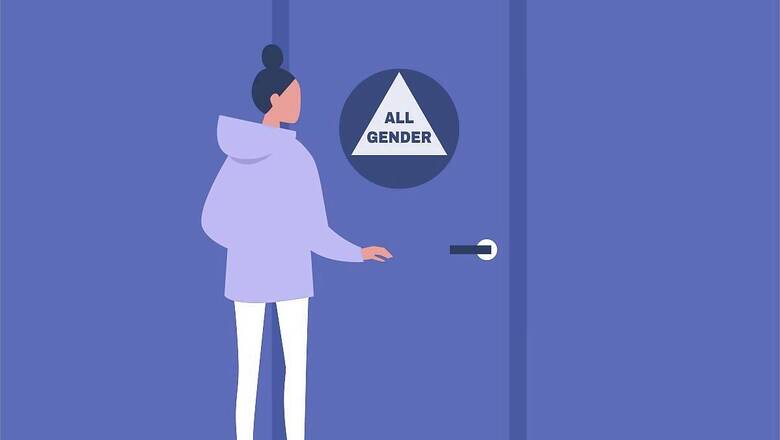
views
Did you know that over 4.5 billion people worldwide do not have access to safe sanitation facilities? That’s almost two-thirds of the global population, and the consequences of poor sanitation can be devastating for public health. The lack of access to clean toilets is not only an inconvenience but also a major health risk. The World Health Organization estimates that 432,000 people die each year from diarrhoeal diseases caused by poor sanitation, with children under the age of five being the most vulnerable. This statistic alone should be enough to convince us that something needs to be done.
In India, the GoI’s Swachh Bharat Mission remedied this by constructing millions of toilets, which is bringing tangible health benefits to these communities. Not only does the introduction of toilets reduce the burden on public health facilities by limiting spread of water borne and poor sanitation related diseases, the construction and maintenance of these facilities creates its own employment. Of course, healthier communities also miss fewer days of work and school.
In today’s world, it is more important than ever to ensure that everyone has access to clean and safe toilets. The United Nations Sustainable Development Goal 6 (SDG 6) aims to achieve universal access to sanitation by 2030. However, in our pursuit of this goal, we need to ensure that we leave no one behind.
The world over, toilets are segregated based on a binary understanding of gender – male and female. This excludes anyone who doesn’t identify as strictly male or female, i.e. people who identify as non-binary, transgender or intersex individuals. Unfortunately, for this group, using gendered toilets can sometimes amount to violence. Even when it doesn’t, it makes for exceedingly stressful experiences.
These experiences occur regularly and can include:
- Transgender women, particularly those whose physique is identifiably male, may be unjustly labelled as impostors or predators and coerced into utilising the men’s toilet or vacating the premises (the women’s toilet).
- Transgender women, when forced to use the men’s toilet, do so with enormous trepidation, for fear of being attacked by transphobic men. The attack doesn’t have to be physical for it to be traumatising. Ask anyone whose bully abused them verbally and emotionally.
- Transgender men might be perceived as interlopers by men, facing verbal or physical confrontation in the men’s restroom.
- Non-binary individuals may find themselves estranged from the gendered options, resorting to using disabled restrooms or refraining from using the facilities altogether.
- Intersex individuals may be subjected to uncomfortable, probing questions and scrutiny regarding their physical attributes and/or medical history.
- Gender non-conforming individuals may be derided, misgendered or attacked based on their attire or appearance.
To address these challenges, collaborative efforts are needed from various stakeholders, including governments, civil society organisations, private sector actors, and local communities.
Creating the right infrastructure
In a survey from the National Center for Transgender Equality, where 27,715 people were surveyed, the results found that approximately 12% of transgender people were verbally harassed in public restrooms, 1% were physically attacked, and 1% were sexually assaulted. At the same time, research has demonstrated that providing access to facilities that correspond to their gender identity reduces suicide rates among transgender individuals. One way to address this need is by implementing gender-neutral toilets or, at the very least, transgender-inclusive facilities in public spaces.
Providing gender-neutral or single-stall toilets in public places such as schools, workplaces, health facilities, and transport hubs makes these places safer and more accessible for everyone. These toilets are designed with features that prioritise privacy and safety, such as individual cubicles with locking doors and gender-neutral signage. By implementing these changes, they aim to create a welcoming environment for everyone, regardless of their gender identity or sexual orientation.
The importance of inclusive toilets cannot be overstated. There are physical repercussions too. As we know, when we don’t feel safe going to the toilet, or when the toilets we have access to are dirty, most of us tend to ‘hold it’. This ‘holding it’ can lead to the development of urinary tract infections, kidney problems, and other related health complications, especially when we do so on a regular basis. This is the unfortunate reality for most gender non-conforming people in India. Since they also tend to restrict their intake of food and water (so they don’t have to go to the toilet), many of these individuals suffer from nutritional deficiencies and gastrointestinal issues. With our hot weather in India, dehydration is also never far behind. By providing inclusive toilets, we not only ensure their basic rights but also promote their overall health and dignity.
Furthermore, inclusive toilets also benefit other marginalised groups, such as people with disabilities or those who require assistance. Parents with young children, and caregivers also find these toilets easier to use, especially when the person they are caring for is of the opposite gender. These toilets also offer greater accessibility and convenience for individuals who may have unique needs. By creating a space that is accessible to all, we foster a sense of inclusivity and equality within our society.
Legal Measures
In India, we’ve made significant strides in recognising and legitimising the rights of the LGBTQ+ community. In 2014, the Supreme Court of India recognized transgender persons as a third gender, setting the foundation for subsequent policies. This recognition has spurred dialogue around gender inclusivity in public spaces, including toilets. In 2018, after 17 years of advocacy and litigation, the Supreme Court also decriminalised homosexuality by repealing Article 377, a colonial era law that had carried over into India’s constitution.
The Supreme Court is currently hearing petitions seeking legal recognition of homosexual couples. A favourable decision here would make India the first country (and the second place) in Asia to allow marriage equality.
Supporting Participation and Research
In order to address the challenges faced by LGBTQ+ individuals in accessing safe and inclusive sanitation facilities, supporting research and innovation play a vital role. It is imperative that we invest in context-specific and user-friendly solutions to ensure that everyone, regardless of their sexual orientation or gender identity, can have access to dignified and comfortable sanitation facilities.
To develop effective solutions, the first step is to understand the specific needs and challenges faced by LGBTQ+ individuals. This requires conducting research and actively engaging with the community to gain insights and perspectives. By listening to their experiences and understanding their requirements, researchers and innovators can develop solutions that truly address their unique needs.
Sanitation solutions should be designed to fit the social, cultural, and legal context of the communities they serve. What may work well in one region may not be applicable in another. Therefore, it is crucial to conduct research that takes into account local factors and designs solutions that are relevant and effective within specific contexts. This could involve considerations such as gender-neutral or gender-inclusive toilet designs, flexible and adaptable facilities, and addressing privacy concerns.
A user-friendly approach is essential in developing inclusive sanitation solutions. It is crucial to create facilities that are easy to understand, navigate, and use. Factors such as clear signage, accessible facilities, and intuitive designs should be considered. Involving LGBTQ+ individuals in the design process and incorporating their feedback is key to ensuring that the resulting solutions truly cater to their needs, ensuring inclusivity and usability.
Technological innovations offer significant potential in improving sanitation solutions for LGBTQ+ individuals. Smart toilets with adjustable settings for privacy and comfort, hygiene solutions tailored to specific needs, and mobile applications providing information on safe and inclusive facilities are examples of innovative technologies that can greatly enhance the accessibility and user experience of sanitation facilities.
Raising Awareness
Supporting research and innovation requires collaboration among various stakeholders, including researchers, academics, NGOs, government agencies, and LGBTQ+ advocacy groups. By fostering collaboration, we can bring together diverse perspectives, expertise, and resources to drive innovation, promote knowledge sharing, and ensure the successful implementation of inclusive sanitation solutions.Raising awareness and sensitising the public about the needs and challenges of LGBTQ+ people in accessing sanitation facilities.
Various initiatives and organisations worldwide are working towards promoting LGBTQ+ inclusivity in toilet access. The Toilets for All campaign is one such initiative aiming to create safe and inclusive toilets for everyone, irrespective of their gender identity or expression. This campaign collaborates with local governments, businesses, and communities to advocate for gender-neutral toilets that allow all individuals to use them comfortably and without fear of discrimination.
Mission Swachhta aur Paani, an initiative by Harpic and News 18, in India, has been at the forefront of promoting cleanliness and toilet sanitation. Their efforts have not only focused on improving infrastructure but also on raising awareness about the importance of hygiene. One of the key aspects of Mission Swachhta aur Paani’s work is their commitment to LGBTQ+ inclusivity. They recognize that members of the LGBTQ+ community often face discrimination and harassment in public spaces, including public toilets. This not only violates their basic rights but also hinders their ability to access essential services. Through Mission Swachhta aur Paani, both Harpic and News 18 have been able to do their part in making significant strides in achieving SDG 6.
Conclusion
In our pursuit of universal toilet access and the fulfilment of SDG 6, we must approach this challenge with both passion and compassion. It is not enough to simply construct toilets; we must ensure that these facilities are inclusive and respectful of the diverse needs of all individuals. By embracing the principle of “Sabka Saath, Sabka Vikas” (Together with everyone, development for all), we can foster a society that leaves no one behind.
The journey towards inclusive toilet access requires us to break down social and cultural barriers that hinder certain groups, especially the LGBTQ+ community, from accessing public toilets. We must challenge harmful stereotypes, prejudice, and discrimination through awareness and understanding. By prioritizing the specific needs of the LGBTQ+ community and creating inclusive toilets, we take a significant step towards ensuring that everyone, regardless of their sexual orientation or gender identity, can access safe and dignified sanitation.
Let us come together, united in our efforts, to support and replicate these inclusive initiatives. By doing so, we build a world where universal toilet access is not merely a basic necessity but also a symbol of inclusivity and equality for all. It is our collective responsibility to champion the rights of every individual and ensure that no one is left behind in the pursuit of progress.
Join us here, to learn how you can play a part in this national transformation.

















Comments
0 comment